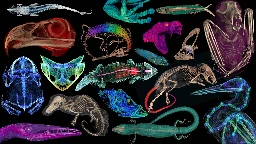Scientists CT scanned thousands of natural history specimens, which you can access for free
Scientists CT scanned thousands of natural history specimens, which you can access for free

Scientists CT scanned thousands of natural history specimens, which you can access for free

cross-posted from: https://lemmy.ca/post/18481281
Over the next four years, the oVert team will CT scan 20,000 fluid-preserved specimens from U.S. museum collections, producing high-resolution anatomical data for more than 80 percent of vertebrate genera.
These digital images and 3D mesh files will be open for exploration, download and 3D printing on MorphoSource, an open-access online database. These new media will provide unprecedented global access to valuable specimens in museum collections and enhance the research value of existing data-rich specimens in iDigBio.
oVert is a multi-institutional project funded by the National Science Foundation.
Video:
https://www.youtube.com/watch?v=JALuBzGvV3g
Some images from the site:
A colorized CT scan of a Burmese horned toad, Brachytarsophrys carinensis, showing the skeleton and mineralized skin. Florida Museum of Natural History image by Ed Stanley
Digitizing specimens through CT scanning makes it easier for museums to share their rare and important specimens. This is the holotype of the rough-footed mud turtle, Kinosternon hirtepes, from the Florida Museum herpetology collection. Florida Museum of Natural History image by Ed Stanley

